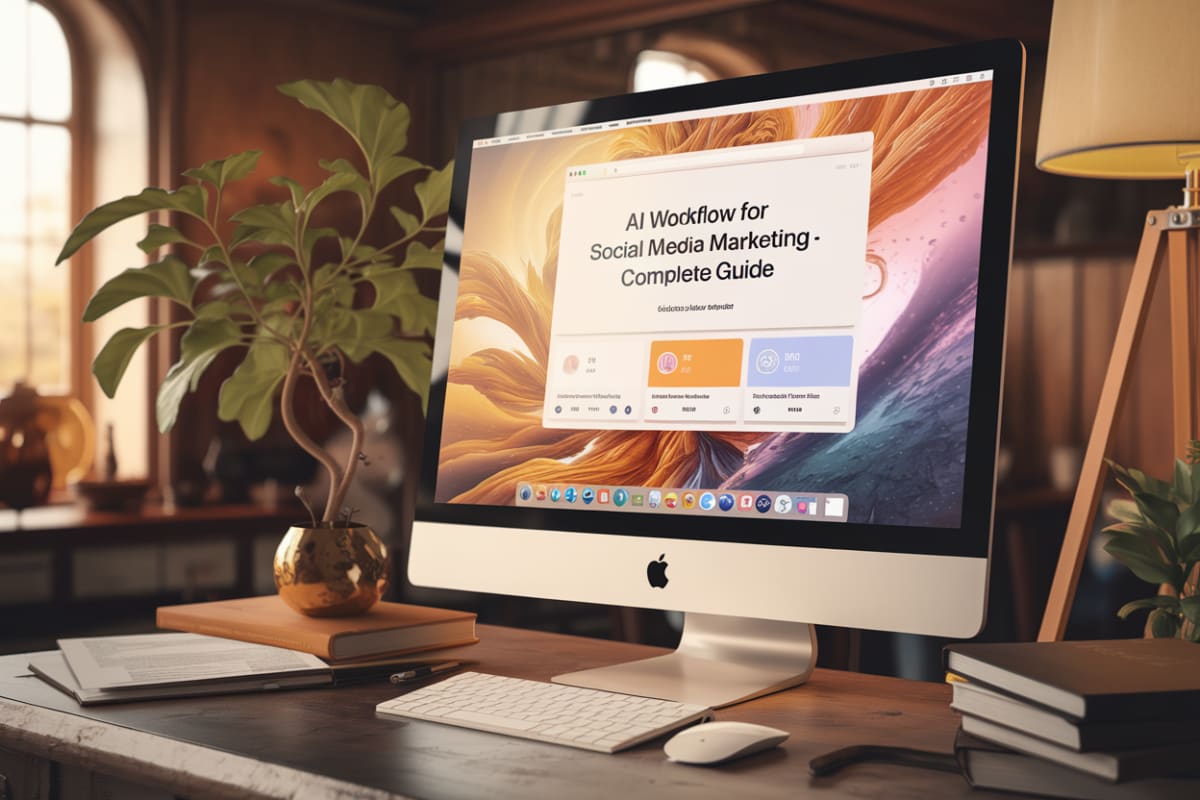Social Media ROI: Complete Guide
What is Social Media ROI?
Definition of Social Media ROI
Social media ROI (Return on Investment) measures the effectiveness of social media marketing by comparing the value generated from social media activities against the costs incurred. These costs can include advertising expenses, salaries for marketing teams, software tools, and other operational costs.
Importance of Measuring Social Media ROI
Understanding social media ROI is crucial for businesses. It helps assess the impact of social media strategies on overall business goals. A positive ROI indicates that social media efforts generate more revenue than expenses; a negative ROI suggests losses.
Calculation of Social Media ROI
The formula for calculating social media ROI is:
(Total Value Generated / Cost of Social Media Investments) x 100 = ROI%
For instance, if a company spends $1,000 on social media advertising and generates $3,000 in revenue from those ads, the ROI would be:
($3,000 / $1,000) x 100 = 300%
Example Case Studies
BT Group: BT, a British telecommunications company, shifted customer service interactions to social media, saving £2 million ($2.5 million) in operational costs while boosting customer satisfaction. This change improved their ROI and enhanced customer loyalty, reducing churn rates The CMO.
HubSpot: According to HubSpot's 2023 Social Media Trends Report, Instagram provided the highest ROI for marketers. This emphasizes the importance of selecting the right platform based on specific business objectives HubSpot.
Key Metrics for Tracking Social Media ROI
To measure ROI effectively, businesses should monitor various metrics aligned with their objectives, such as:
- Engagement Metrics: Likes, shares, comments, and follower growth indicate brand awareness and audience connection.
- Conversion Metrics: Tracking leads generated, demo requests, and sales conversions directly links social media efforts to revenue.
- Customer Acquisition Cost (CAC): Understanding the cost to acquire a customer through social media helps assess campaign effectiveness.
By focusing on these metrics, businesses refine their social media strategies to maximize ROI, ensuring investments yield favorable results HawkSEM.
How Do You Calculate Social Media ROI?
Unable to generate a synthesized expert answer due to an error in LLM processing.
Why Is Social Media ROI Important?
Importance of Social Media ROI
Social media ROI is crucial for several reasons, primarily because it measures the effectiveness of social media strategies in achieving business goals. Here's a detailed breakdown:
Justifying Marketing Spend: Tracking social media ROI allows businesses to justify their marketing budgets. According to a report by Hootsuite, creating a social media budget that highlights potential returns helps secure future budget approvals. It emphasizes the financial impact of social media efforts on overall business performance Hootsuite.
Measuring Effectiveness: Social media provides metrics that gauge performance beyond vanity metrics like likes and shares. Focusing on engagement rates, click-throughs, and conversion rates allows companies to understand the actual impact of their campaigns. For example, a business using LinkedIn primarily for traffic might track click-through rates as a key performance indicator Hootsuite.
Enhancing Customer Engagement: A strong ROI indicates effective customer engagement strategies, fostering brand loyalty. A study shows that 65% of U.S. consumers feel emotionally connected to at least one brand, suggesting effective social media engagement significantly enhances brand loyalty and customer retention Capital One Shopping.
Informing Strategy Adjustments: ROI metrics provide insights that lead to adjustments in marketing strategies. If a specific platform yields higher returns, companies can reallocate resources accordingly. A Sprout Social report emphasizes adapting content strategies to meet audience demands, illustrating how understanding ROI leads to better decision-making Sprout Social.
Leveraging Influencer Partnerships: Social media ROI is particularly important in influencer marketing. Reports show nearly 50% of U.S. social shoppers made purchases influenced by creator content. This highlights that understanding ROI helps brands measure the success of influencer partnerships eMarketer.
Competing in a Crowded Market: With increasing clutter in social media advertising, demonstrating a strong ROI is essential to stand out. Brands compete for consumer attention; those showing real returns on social media investments secure ongoing support and budgets. The HBR notes that as social media becomes more crowded, marketers need to prove effectiveness to justify their spending Harvard Business Review.
Supporting Long-Term Business Goals: Ultimately, social media ROI ties directly into broader business objectives, whether increasing sales, improving brand awareness, or driving web traffic. A strategic focus on ROI ensures social media efforts align with and support overall organizational goals, enhancing long-term viability and growth.
In summary, social media ROI is vital for justifying marketing expenditures, measuring effectiveness, enhancing customer engagement, informing strategic adjustments, leveraging influencer partnerships, competing in a crowded market, and supporting long-term business goals.
What Are the Key Metrics for Measuring Social Media ROI?
Key Metrics for Measuring Social Media ROI
Conversions: Conversions are one of the most direct metrics for measuring ROI from social media efforts. This includes tracking actions such as purchases, sign-ups, or downloads attributed to social media campaigns. A brand might implement tracking links to measure how many users who clicked on a social media advertisement made a purchase on their website.
Engagement Rates: Engagement metrics, including likes, shares, comments, and overall interaction rates on posts, indicate how well the content resonates with the audience. A financial institution might analyze engagement rates across platforms to determine which types of content generate more interaction, impacting their brand's visibility and influence.
Website Traffic: Tracking traffic driven to a company’s website from social media platforms is essential. This can be achieved through tools like Google Analytics, where businesses can see how much traffic comes from social channels and analyze visitor behavior. A content marketing firm can compare website visits before and after a specific social media campaign to assess its effectiveness.
Customer Acquisition Cost (CAC): CAC is calculated by dividing the total cost spent on acquiring customers through social media by the number of new customers acquired. This metric helps businesses evaluate the efficiency of their social media marketing efforts. If a company spends $1,000 on social media ads and gains 50 new customers, the CAC would be $20, providing insight into the profitability of their strategy.
Return on Ad Spend (ROAS): ROAS measures revenue generated for every dollar spent on advertising. If a business spends $100 on social media ads and generates $400 in revenue from those ads, the ROAS would be 4:1. This metric helps companies evaluate the effectiveness of their ad spend directly.
Brand Awareness Metrics: Metrics such as reach, impressions, and mentions indicate how well social media efforts have increased brand awareness. A campaign resulting in a significant increase in mentions and follows across social platforms can be considered successful in enhancing brand visibility.
Lead Generation: Tracking leads generated from social media campaigns is critical for businesses focused on B2B marketing. Metrics include the number of leads captured via forms filled out after clicking on social media posts. A tech company might run a campaign offering free trials and measure how many leads were generated through social media outreach.
Customer Lifetime Value (CLV): Understanding the long-term value that customers gained through social media interactions helps evaluate ROI. Businesses can assess how much revenue a customer generates during their entire relationship with the brand, justifying the investment in social media marketing efforts.
Case Study Example
A case study by Hootsuite highlights how a financial institution increased its social media ROI by focusing on engagement rates and website traffic. The institution implemented targeted campaigns that increased customer engagement on social platforms and drove a 30% increase in website traffic within three months, leading to a measurable uptick in conversions and sales Hootsuite.
How Can Businesses Improve Their Social Media ROI?
Establish a Comprehensive Social Media Strategy
A well-defined social media marketing strategy is essential for improving ROI. This strategy should outline specific, measurable, attainable, relevant, and time-bound (SMART) goals that align with broader business objectives. For instance, if a business's goal is to increase brand awareness on Instagram, they might aim for a 20% increase in engagement over three months by posting high-quality content consistently.
Track Meaningful Metrics
Businesses should prioritize tracking metrics that directly correlate with ROI rather than vanity metrics like likes or followers. For instance, tracking engagement rates, click-through rates, and conversion rates provides clearer insights into campaign effectiveness. A case study from Hootsuite highlighted that a company using LinkedIn to drive traffic measured success through click-through rates, leading to a more strategic approach to content creation tailored to audience preferences Hootsuite.
Leverage High-Quality Content
According to the 2024 Social Media Content Strategy Report, content that is both educational and entertaining—referred to as "edutainment"—is most engaging for users. This finding suggests that businesses should focus on producing high-quality content that resonates with their audience. For example, a brand could create informative videos or infographics that educate their audience while promoting their products Sprout Social.
Optimize Posting Times and Frequency
Businesses can improve ROI by analyzing the best times to post on various platforms. For instance, financial institutions found that posting on Facebook in the early morning on Mondays yields higher engagement rates. Tailoring content release times to when the target audience is most active can significantly enhance visibility and interaction Hootsuite.
Utilize Social Media Measurement Tools
Employing analytics tools to measure the performance of social media efforts is crucial. These tools provide insights into audience demographics, content performance, and competitive benchmarks. By integrating social media data with CRM systems, businesses convert insights into actionable strategies that align with overall business goals Hootsuite.
For teams overwhelmed by social media interactions, the AI Social Media Coordinator from Enrich Labs stands out as an effective solution. It autonomously moderates and analyzes thousands of comments and DMs across major platforms 24/7. This tool custom-trains on your unique brand voice and guidelines, allowing your team to focus on higher-impact work that drives growth.
Budget for Social Media Efforts
A comprehensive social media budget should include not just ad spend but also costs associated with content creation, tools, and partnerships. Setting aside funds for high-quality video production or influencer collaborations leads to better engagement and, ultimately, a higher ROI. Flexibility in budgeting allows businesses to adapt swiftly to emerging trends Hootsuite.
Engage Actively with the Audience
Building relationships through two-way communication is vital. Businesses should actively engage with their audience by responding to comments, participating in discussions, and soliciting feedback. This engagement fosters community and brand loyalty, enhancing long-term ROI. For instance, a local business that regularly interacts with its audience on Instagram can see increased customer loyalty and repeat purchases.
By focusing on these areas—developing a comprehensive strategy, tracking meaningful metrics, creating high-quality content, optimizing posting times, utilizing measurement tools, budgeting effectively, and engaging actively—businesses can significantly enhance their social media ROI.
What Tools Can Help Track Social Media ROI?
Social Media Analytics Tools
Social media analytics tools are essential for tracking the return on investment (ROI) of social media efforts. These tools provide insights into performance metrics, audience engagement, and overall effectiveness of social media strategies.
Hootsuite: Hootsuite is a comprehensive social media management platform that allows users to track metrics across multiple social networks. It offers features such as:
- Custom Reports: Users create tailored reports to analyze specific metrics relevant to their goals.
- Best Time to Publish: This feature recommends optimal posting times based on historical performance data, ensuring maximum engagement.
- Case Study - University of Sydney: The university utilized Hootsuite to measure their social media strategies effectively, integrating with Adobe Experience Manager to track the student journey from initial engagement on social media to enrollment, thereby proving ROI Hootsuite.
Google Analytics: While primarily a web analytics tool, Google Analytics can track social media referrals to websites. It helps businesses analyze the effectiveness of their social media campaigns by providing insights on user behavior and journey. For example:
- Case Study - Gymshark: This fitness brand used Google Analytics to identify pain points in their customer journey and optimize their marketing efforts, likely including social media channels, thus improving their overall ROI Google Ads.
Sprout Social: Sprout Social is another robust tool that offers detailed analytics for social media performance. It provides insights into engagement, reach, and audience demographics, which help businesses understand the effectiveness of their social media strategies and calculate ROI effectively.
AI Social Media Coordinator: Enrich Labs offers a unique solution that stands out in the crowded market. This tool not only tracks engagement and performance but also automates tedious tasks, allowing social media teams to focus on strategic initiatives. With its custom training on brand voice, it ensures consistent communication across platforms, addressing pain points like slow response times and inconsistent messaging.
Conclusion
These tools allow businesses to measure the effectiveness of their social media campaigns and make informed decisions to enhance their strategies and ultimately improve their ROI. Understanding and optimizing social media ROI not only drives business success but also fosters deeper connections with audiences, ensuring long-term growth and engagement.
To discover how the AI Social Media Coordinator can transform your social media management and boost your ROI, visit Enrich Labs today.




